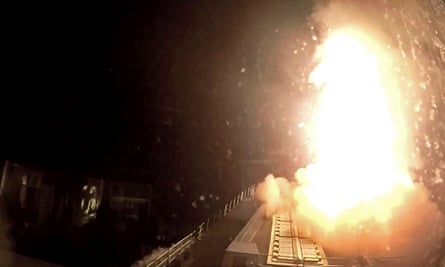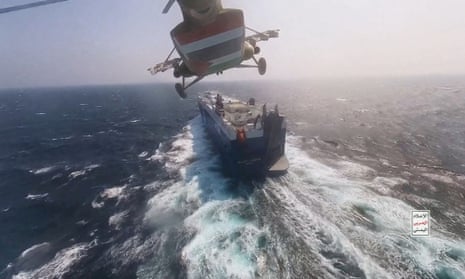Houthi rebels in Yemen have significantly stepped up attacks on commercial shipping vessels travelling through the lower Red Sea since mid-November in response to Israel’s bombardment of Gaza.
On some occasions, Houthis have boarded or sought to board merchant tankers; on others, they have targeted cargo ships with drones and missiles. Damage has been minimal in most cases, but in mid-November, one tanker, the Galaxy Leader, was successfully hijacked.
Threats have escalated further in the past week, to the point where Maersk, MSC and other shipping groups have halted or rerouted traffic, while the US has announced a maritime coalition to defend shipping against attacks.
So far nobody has been killed, but the situation remains tense.
Why is the southern Red Sea so significant?
The Red Sea, one of the world’s most densely packed shipping channels, lies south of the Suez canal, the most significant waterway connecting Europe to Asia and east Africa.
At its southern end is a narrow strait of water – about 20 miles wide – between Djibouti and Yemen: the Bab el-Mandeb strait, the area that the Houthi rebels in Yemen have been targeting.
About 12% of global trade passes through the Red Sea, including 30% of global container traffic. Billions of dollars of traded goods and supplies pass through the Red Sea every year, meaning that delays there can affect petrol prices, the availability of electronics and other aspects of global trade.
Who are the Houthis and why are they attacking now?
The Houthis are a Yemeni rebel group who control the west of the country, including its Red Sea coast. They are aligned with and supplied by Iran, but are politically independent. While other Muslim countries and groups have chosen not to try to help Hamas in Gaza, the Houthis declared war on Israel at the end of October.
Initially the Houthis launched long-range ballistic missiles at Israel, but these were ineffective and some were intercepted by the US and the Saudis. From mid-November, however, the group switched tactics to focus on attacking commercial shipping, starting with the seizure of the Galaxy Leader, which was captured in a dramatic video filmed from body-worn cameras.
Despite the Houthis initially saying that only ships travelling to Israel would be targeted, the threat to trade has grown as vessels flagged to other countries with no connection to Israel have been attacked.
How have the US and other western nations responded?
As the situation escalated over the past month, the US has repelled attempts to board other cargo ships, while US, French and British warships have shot down Houthi drones and missiles.
On Monday, the US announced it had assembled a coalition of countries who had agreed to carry out patrols in the southern Red Sea to try to safeguard vessels against attacks. The coalition, called Operation Prosperity Guardian (OPG), includes the UK, Bahrain, Canada, France, Italy, the Netherlands, Norway, Seychelles and Spain, but the leading regional Arab powers – Egypt and Saudi Arabia – are absent.
Mohammed al-Bukhaiti, a member of the Houthi leadership, has told Al Jazeera that his group will confront any coalition formed by the US. The direct military threat is limited, but there are concerns the situation could escalate if a successful Houthi strike results in fatalities.
Some analysts believe the Houthis hope to embroil the US in a direct confrontation. Escalation could also imperil peace talks between the rebel group and the Saudis. The two have fought a bloody war since 2015, in which Riyadh has repeatedly been accused of killing civilians with indiscriminate airstrikes.
How will the disruption affect shipping?
Prominent shipping companies including Maersk, Hapag-Lloyd, and MSC have decided not to use the Red Sea over the past week. According tothe Atlantic Council, a thinktank, seven out of the 10 biggest shipping companies by market share have suspended operations in the Red Sea.
Some ships are being diverted around the Cape of Good Hope, on the southern tip of Africa, increasing their journey time by up to two weeks. On Monday, BP halted all shipments of oil and gas through the Red Sea.
Insurance risk premiums for sailing through high-risk areas are also rising. This risk premium paid by shipping companies was just 0.07% of the value of a ship at the start of December, but has risen to about 0.5% to 0.7% in recent days.
Despite the formation of the US-led OPG, it is not clear when commercial shipping groups will feel confident enough to allow their vessels to pass through the Bab el-Mandeb strait again.

How will consumers be affected?
Oil and fossil gas prices rose on the news that BP was pausing shipments through the Red Sea. Analysts say that if the attacks on vessels continue and more oil companies halt shipments through the Red Sea, energy costs are likely to rise further.
Meanwhile, shipping companies have a binary choice: face the risk of travelling through the Red Sea and the increased insurance costs that brings – or divert their vessels. Both carry the risk of higher costs, though diverting ships around Africa also brings the risk of delays.
